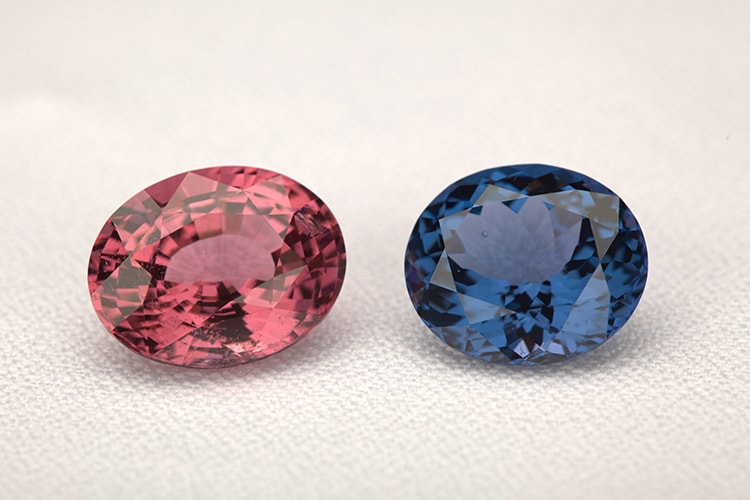Guide to Spinel

History, Lore and Appreciation
Spinel has long been one of the most underestimated gems on Earth, but that is rapidly changing. With education, there is a greater understanding and appreciation for the gemstone’s unique optical characteristics, its broad color palette, its rarity, and versatility.
Red spinel has been known since ancient times, and for years it was referred to as “balas ruby” because the main historical source for the material was in present-day Tajikistan in a region called Badakhshan. In the chapter on ruby, it was noted that the Black Prince’s Ruby, the centerpiece of the British Imperial State Crown is actually a spinel. Another famous gem spinel set in the crown of Queen Victoria is the so-called Timur Ruby, a 361 carat gemstone that is also a spinel. Many other historical red gems decorating the crowns of Europe and in Asia are, in fact, spinel. Spinels stand on their own as magnificent and long- celebrated gems.
Appreciation for spinel inevitably brings us to one of the world’s greatest collectors of gemstones. Among the Iranian crown jewels is one named the Samarian Spinel. Weighing approximately 500 carats, it is thought to be the world’s largest fashioned spinel. Its provenance dates back to the 18th Century Persian conquest of India. An inscription on the back of the spinel confirms that the great Indian Mughal gem collector, Jahangir, had once owned it. Interestingly, the Timur spinel in the British crown jewels bears an inscription indicating Jahangir had also owned it.
Much of the appreciation for spinel is due to its unique gemology. There is a clarity and directness about spinel that many enthusiasts appreciate. Optically, spinel is singly refractive, meaning that light passing through it in any given direction is not split into two rays. Spinel has a high refractive index, and many transparent gems are relatively inclusion-free. Finally, spinel has moderate dispersion. This combination of optical characteristics renders spinel bright and reflective, and capable of breaking up white light into
spectral hues – what we call “fire.” It may be this fire that first gave spinel its name: one derivation of the word comes from the Greek spinter – meaning “spark.” Another theory suggests that the word comes from the Latin spina, alluding to the sharp points in the octahedral crystals.
Birthstones and Anniversaries
Spinel is one of the birthstones for August and it is used to commemorate a 22nd wedding anniversary.
Description and Properties
Spinel is a mineral species, member of the spinel group, whose varieties are primarily distinguished by their color. It forms in the cubic crystal system, and its basic chemical composition is: MgAl204.
Colors: red, pink, orange, blue, violet, purple and grey are the most common colors. Other colors include brown and black, and rarely, yellow, green and near colorless. Color-change spinel changes from greyish blue in daylight to purple in incandescent light. Vivid cobalt-blue spinel is colored by cobalt.
Refractive Index: 1.718 (+0.017, -0.008)
Birefringence: None
Specific Gravity: 3.60 (+0.10, -0.03)
Cause(s) of color: Blue: iron, cobalt. Red to pink: chromium
Mohs Hardness: 8
Internal identifying characteristics: Minute fingerprint inclusions may be seen in spinel. With sufficient magnification, tiny octahedral crystals or negative crystals may be seen. These octahedral crystals, if large enough, may be accompanied by strain halos.
Treatments
Spinel is rarely treated, though occasional heating of pink-to-red spinel has been reported. Infrequently, surface reaching fissures are treated with oils or polymers.
Collector Quality
Color, carat weight, clarity and origin all play a role in how spinel is valued and collected. Gems whose provenance can be ascertained always have collectors. Spinel that is deep red, large and relatively free of inclusions is also highly desired. So too is rare, vivid blue spinel, particularly when a gemological laboratory has determined that cobalt is the coloring agent. Locality plays an important role for collectors as well. Spinel from the Pamir Mountains
in Central Asia is rare and collectible, as is spinel from Myanmar (Burma). New localities that produce desirable color
– anywhere from pink to deep red are collectible.
Localities
Tajikistan – especially in the region of Badakhshan, in the Pamir Mountains, remains a classic source for the gem and the main source for large sized gems. Neighboring Afghanistan is also a known source. Myanmar (Burma) is also a classic source and remains a strong producer of the material. Sri Lanka, Cambodia, Thailand, Vietnam, Kenya, Tanzania, and Russia have all produced spinel. Recent spinel finds in East Africa and Asia have reinvigorated interest in the gem.
Cutting, Care and Cleaning
Spinels are resilient and tough – more so than many gems (except corundum or diamond.) They may be cleaned in an ultrasonic cleaner or steam cleaned. It is preferable to simply use a damp soft cloth or a soft bristle toothbrush to clean the gemstones and spinel jeweler.
Source: CIBJO